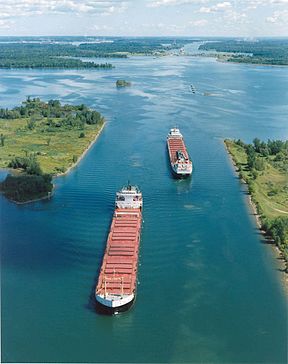| St. Lawrence Seaway | |
|---|---|
 | |
 | |
| Specifications | |
| Length | 370 miles (600 km) |
| Maximum boat length | 740 ft 0 in (225.6 m) |
| Maximum boat beam | 78 ft 0 in (23.8 m) |
| Maximum boat draft | 12.5 m (downstream of Quebec City), 10.7 m (Quebec City to Deschaillons), 11.3 m (Deschaillons to Montreal), 8.2 m (upstream of Montreal) |
| Locks | 15 |
| Maximum height above sea level | 570 ft (170 m) |
| Status | Open |
| History | |
| Construction began | 1954 |
| Date of first use | April 25 |
| Date completed | 1959 |
| Geography | |
| Start point | Port Colborne, Ontario |
| End point | Montreal, Quebec |



The St. Lawrence Seaway (French: la Voie Maritime du Saint-Laurent) is a system of locks, canals, and channels in Canada and the United States that permits oceangoing vessels to travel from the Atlantic Ocean to the Great Lakes of North America, as far inland as Duluth, Minnesota, at the western end of Lake Superior. The seaway is named for the St. Lawrence River, which flows from Lake Ontario to the Atlantic Ocean. Legally, the seaway extends from Montreal, Quebec, to Lake Erie, and includes the Welland Canal. Ships from the Atlantic Ocean are able to reach ports in all five of the Great Lakes, via the Great Lakes Waterway.
The St. Lawrence River portion of the seaway is not a continuous canal; rather, it consists of several stretches of navigable channels within the river, a number of locks, and canals along the banks of the St. Lawrence River to bypass several rapids and dams. A number of the locks are managed by the St. Lawrence Seaway Management Corporation in Canada, and others in the United States by the Great Lakes St. Lawrence Seaway Development Corporation; the two bodies together advertise the seaway as part of "Highway H2O".[1] The section of the river from Montreal to the Atlantic is under Canadian jurisdiction, regulated by the offices of Transport Canada in the Port of Quebec.
- ^ "HWY H2O - Home". Archived from the original on 2014-11-06. Retrieved 2014-08-15.